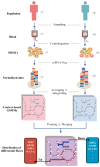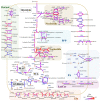Reconstructed Genome-Scale Metabolic Model Characterizes Adaptive Metabolic Flux Changes in Peripheral Blood Mononuclear Cells in Severe COVID-19 Patients
- PMID: 36293257
- PMCID: PMC9604493
- DOI: 10.3390/ijms232012400
Reconstructed Genome-Scale Metabolic Model Characterizes Adaptive Metabolic Flux Changes in Peripheral Blood Mononuclear Cells in Severe COVID-19 Patients
Abstract
Coronavirus disease 2019 (COVID-19) caused by severe acute respiratory syndrome coronavirus-2 (SARS-CoV-2) poses a mortal threat to human health. The elucidation of the relationship between peripheral immune cells and the development of inflammation is essential for revealing the pathogenic mechanism of COVID-19 and developing related antiviral drugs. The immune cell metabolism-targeting therapies exhibit a desirable anti-inflammatory effect in some treatment cases. In this study, based on differentially expressed gene (DEG) analysis, a genome-scale metabolic model (GSMM) was reconstructed by integrating transcriptome data to characterize the adaptive metabolic changes in peripheral blood mononuclear cells (PBMCs) in severe COVID-19 patients. Differential flux analysis revealed that metabolic changes such as enhanced aerobic glycolysis, impaired oxidative phosphorylation, fluctuating biogenesis of lipids, vitamins (folate and retinol), and nucleotides played important roles in the inflammation adaptation of PBMCs. Moreover, the main metabolic enzymes such as the solute carrier (SLC) family 2 member 3 (SLC2A3) and fatty acid synthase (FASN), responsible for the reactions with large differential fluxes, were identified as potential therapeutic targets. Our results revealed the inflammation regulation potentials of partial metabolic reactions with differential fluxes and their metabolites. This study provides a reference for developing potential PBMC metabolism-targeting therapy strategies against COVID-19.
Keywords: COVID-19; PBMCs; inflammatory; metabolic model; metabolism; metabolism-directed therapy.
Conflict of interest statement
The authors declare no conflict of interest.
Figures




Similar articles
-
Mitochondrial metabolic manipulation by SARS-CoV-2 in peripheral blood mononuclear cells of patients with COVID-19.Am J Physiol Cell Physiol. 2021 Jan 1;320(1):C57-C65. doi: 10.1152/ajpcell.00426.2020. Epub 2020 Nov 5. Am J Physiol Cell Physiol. 2021. PMID: 33151090 Free PMC article.
-
Single-Cell RNA Sequencing Analysis of the Immunometabolic Rewiring and Immunopathogenesis of Coronavirus Disease 2019.Front Immunol. 2021 Apr 14;12:651656. doi: 10.3389/fimmu.2021.651656. eCollection 2021. Front Immunol. 2021. PMID: 33936072 Free PMC article.
-
A Path-Based Analysis of Infected Cell Line and COVID-19 Patient Transcriptome Reveals Novel Potential Targets and Drugs Against SARS-CoV-2.Front Immunol. 2022 Jul 1;13:918817. doi: 10.3389/fimmu.2022.918817. eCollection 2022. Front Immunol. 2022. PMID: 35844595 Free PMC article.
-
Pathogenesis-directed therapy of 2019 novel coronavirus disease.J Med Virol. 2021 Mar;93(3):1320-1342. doi: 10.1002/jmv.26610. Epub 2020 Nov 10. J Med Virol. 2021. PMID: 33073355 Review.
-
Current status of antivirals and druggable targets of SARS CoV-2 and other human pathogenic coronaviruses.Drug Resist Updat. 2020 Dec;53:100721. doi: 10.1016/j.drup.2020.100721. Epub 2020 Aug 26. Drug Resist Updat. 2020. PMID: 33132205 Free PMC article. Review.
References
-
- Giamarellos-Bourboulis E.J., Netea M.G., Rovina N., Akinosoglou K., Antoniadou A., Antonakos N., Damoraki G., Gkavogianni T., Adami M.-E., Katsaounou P., et al. Complex Immune Dysregulation in COVID-19 Patients with Severe Respiratory Failure. Cell Host Microbe. 2020;27:992–1000.e3. doi: 10.1016/j.chom.2020.04.009. - DOI - PMC - PubMed
-
- Kyriazopoulou E., Leventogiannis K., Norrby-Teglund A., Dimopoulos G., Pantazi A., Orfanos S.E., Rovina N., Tsangaris I., Gkavogianni T., Botsa E., et al. Macrophage Activation-like Syndrome: An Immunological Entity Associated with Rapid Progression to Death in Sepsis. BMC Med. 2017;15:172. doi: 10.1186/s12916-017-0930-5. - DOI - PMC - PubMed
-
- Lukaszewicz A.-C., Grienay M., Resche-Rigon M., Pirracchio R., Faivre V., Boval B., Payen D. Monocytic HLA-DR Expression in Intensive Care Patients: Interest for Prognosis and Secondary Infection Prediction. Crit. Care Med. 2009;37:2746–2752. - PubMed
MeSH terms
Substances
Grants and funding
LinkOut - more resources
Full Text Sources
Medical
Miscellaneous

